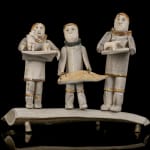-
ROMEO EEKERKIK (1923-1983) ARVIAT (ESKIMO POINT)
Making a Living, 18 February 1976antler, pigment, and graphite, 9.25 x 11 x 5.75 in (23.5 x 27.9 x 14.6 cm)
dated, signed, and inscribed, " FEBRUARY 1976 18 / R ᐃᑲᑭ / ᐅᓗᒥ (today?)".LOT 58
ESTIMATE: $800 — $1,200
PRICE REALIZED: $2,684.00Further images
-
(View a larger image of thumbnail 1
)

-
(View a larger image of thumbnail 2
)

-
(View a larger image of thumbnail 3
)

-
(View a larger image of thumbnail 4
)

-
(View a larger image of thumbnail 5
)

-
(View a larger image of thumbnail 6
)

-
(View a larger image of thumbnail 7
)

-
(View a larger image of thumbnail 8
)

The pioneer Inuit art historian George Swinton reminds us: “One of the Inuktitut words used in earlier times for carvings was pinguaq, meaning toy (or ‘playful imitation’), as opposed to...The pioneer Inuit art historian George Swinton reminds us: “One of the Inuktitut words used in earlier times for carvings was pinguaq, meaning toy (or ‘playful imitation’), as opposed to sananguaq which has now acquired the meaning of ‘carving’ and of ‘art’ in general. The ethic of making a carving a pinguaq is still pretty strong in Eskimo Point.” [1] In our view, Eekerkik’s wonderful antler constructions are among the best shining examples of this aesthetic.
Making a Living brilliantly and charmingly conveys the traditional versus the more modern form of livelihood in Canada’s Arctic. The figure at centre proudly displays a large fish he has caught. He is flanked by two Inuit carvers presenting their wares to us. Marvelous.
1. See Swinton’s essay “Memories of Eskimo Point 1967-1979” in Driscoll, Eskimo Point/Arviat, (WAG, 1982), p. 14.Provenance
Private Collection, Lunenburg, NS. -
(View a larger image of thumbnail 1
)
Join our mailing list
* denotes required fields
We will process the personal data you have supplied in accordance with our privacy policy (available on request). You can unsubscribe or change your preferences at any time by clicking the link in our emails.








